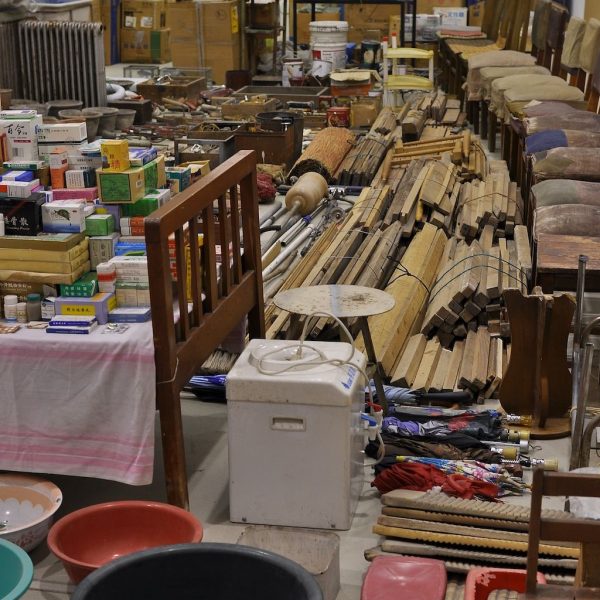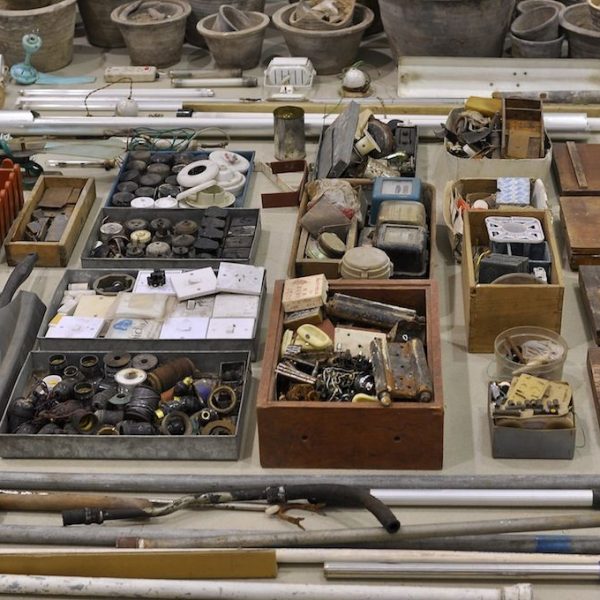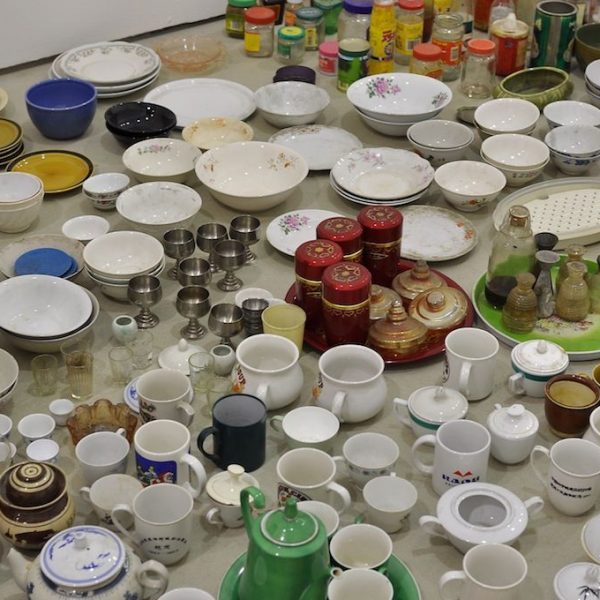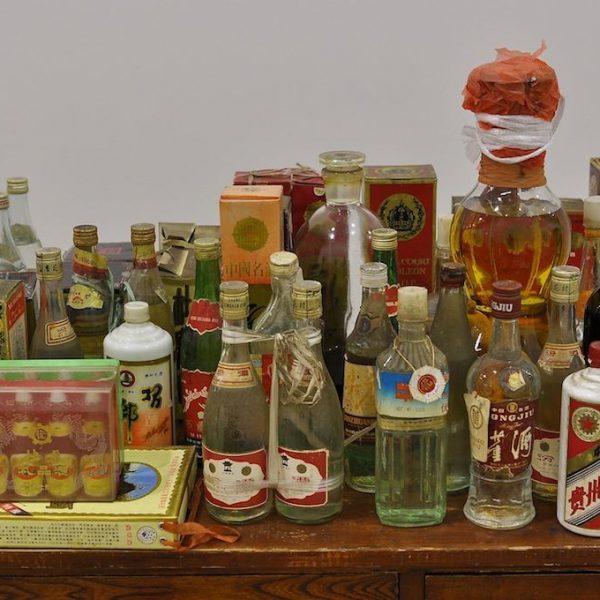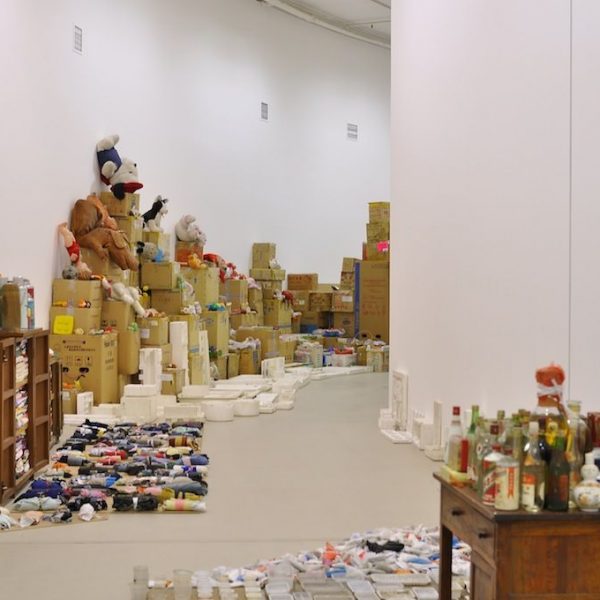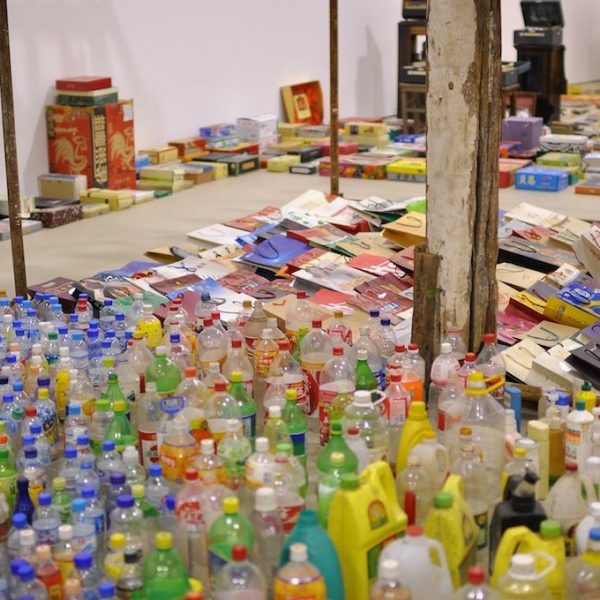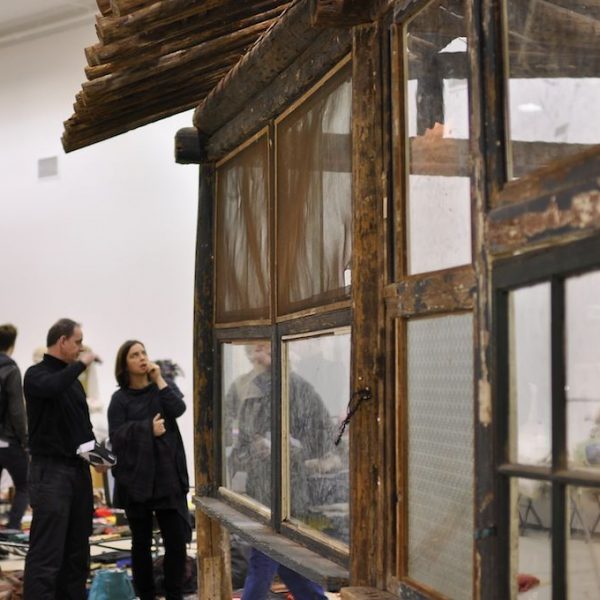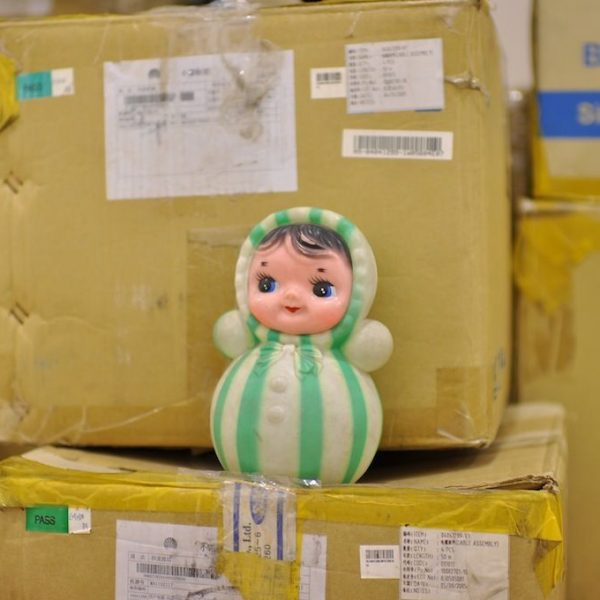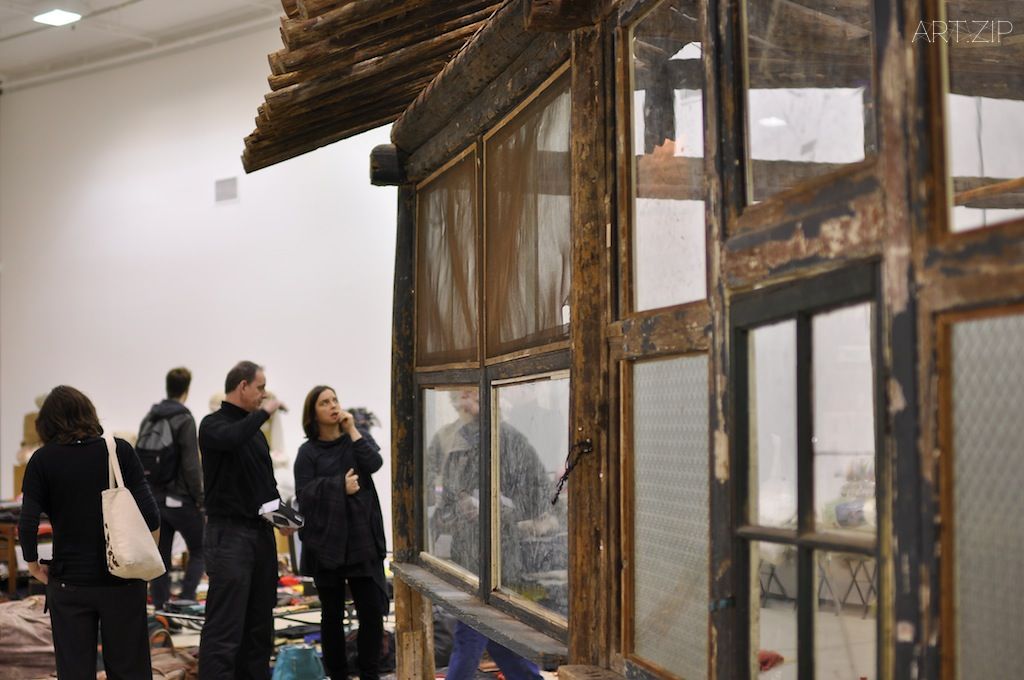
撰文:林上童,劉競晨
翻譯:Trish Lyons
Written by : Lin Shangtong, Harry Liu
Translated by:Trish Lyons
攝影:劉競晨
Photography by:Harry Liu
Waste Not was the UK debut solo exhibition by Chinese artist, Song Dong that took place in the Curve in The Barbican Centre, London. The exhibition consisted of a single installation comprising over 10,000 commonplace, domestic items of daily life that had been used and amassed by the artist’s mother (Zhao Xiangyuan) over fifty years. The shabby and sometimes thread bare items were arranged throughout the curved space of the gallery along the lines of a Chinese traditional garden with serpentine pathways and changes in scale serving to draw in the viewer, whilst re-casting the collective memory of an entire generation under Mao Tse-tung’s reign.
Song Dong (b. 1966) started exhibiting in China, in the 1990s. His broad practice includes installation, performance, and new media with themes revolving around simple daily life. Song believes that art should not be treated as a commodity, but as an experience that integrates life and consciousness. Song‘s artworks revolve around different themes, but for the most part his work relates to his personal life experiences and emotions. One such noted work is ‘Writing Diary with Water’ (1995 – ongoing) where Song uses a calligraphy brush to write diary entries in water on a particular block of stone, when the water vaporizes, his diary disappears with it. The block of stone has become a part of Song’s life, “although this block of stone does not weight much, to me, it is heavy.” For the artist, art is neither mystical knowledge nor a virtuous career, but life itself.
At the entrance of Waste Not, an old calendar falls on the date 18th October 2002. This is the day that Song Dong’s father died of a heart attack. Since then, the calendar from the family home has remained on this page. No one has torn off this page to reveal the next day. From this point on, Mrs Zhao Xiangyuan’s behaviour suddenly and dramatically changed as she became locked in a self-enclosed world.
It was generally understood that Zhao Xiangyuan’s sudden mental collapse was a response to her husband’s sudden death. However, it transpires that the seeds were sown during her traumatic childhood. The grief for her husband simply triggered her symptoms.
Zhao Xiangyuan was born into a wealthy family in 1938. Her father was a Kuomintang officer who was awarded an honour in the War of Resistance for saving an underground member of the Communist Party in Chongqing. However, in 1953, Zhao’s father was betrayed by a Kuomintang secret agent and the underground member he had saved refused to testify in court. Her father was sentenced to seven years imprisonment and after his release he worked in a button factory in Beijing until retirement. Tragically, shortly after his release from prison, in 1961, Zhao’s mother died from cancer, which came as a tremendous blow to Zhao. This was followed by the Three Years of Great Chinese Famine in which the entire family became poor. This succession of sad events left an indelible shadow on Zhao’s young mind. It was at this time, that Song Dong’s father appeared, providing great comfort to his mother.
Thrift is a common virtue of Chinese people and became a means of survival and a way of life for most Chinese families of that era. For many years, Zhao Xiangyuan stored a large number of daily necessities. The installation Waste Not is not only a physical document of Zhao’s life but also the portrait of a generation. During Song Dong’s childhood, Zhao always bought bits of cloth so that she could make clothes. Purchasing bits of fabric cost less then clothing coupons that were rationed by the government and the panic of material scarcity led her to save lots of material. As long as the object could still be used, it was not to be thrown away. This mindset and humble lifestyle has had a psychological impact on future generations. The contrast between Zhao’s generation and that of Song’s could not be more severe. The survival instincts of a generation that had learned to save and not waste have been lost to the present generation where opulence and obsolescence thrives. China’s economic rise in the global world and its shift in policy has unwittingly drawn a deep divide between two generations and the relationship between Song Dong and his parents was no exception to this.
From the time of the death of her husband, Zhao Xiangyuan began to keep obsolete objects and items. This grew to become a hoarding obsession. Inside the house, there was no space, and throwaway items were not discarded. Song Dong and his sister tried to organise all the items and even discarded some, which displeased their mother. With her husband gone, the empty room was unbearable. The items and detritus she collected formed new memories for her, filling the space around her as she hid in this cocooned private world, seeking an illusory safety and warmth.
In traditional Chinese culture, to respect one’s parents’ lifestyle is filial piety. Song Dong thought that as long as his mother was happy, she could do whatever she liked. Therefore, he adapted his own life and work, by sharing her life, her material items and adopting her philosophy on life. He also started to make work with the ‘no waste’ principle. Art as he had understood it up to this point, was no longer important, what mattered was drawing his mother out of her grief.
In 2005, Waste Not was exhibited at Beijing Tokyo Art projects, 798 Factory, Beijing. The work was divided into four major categories: something to wear, something to eat, somewhere to live and something to use. The installation allowed for a conversation around objects, memories and family ethics against the background of contemporary China.
The exhibition provided Zhao Xiangyuan a place to organize and recall her history and also became a reflection of today’s consumerist society. Zhao was pushed into becoming an artist and Song Dong played a role as her son and assistant to help her organize and decorate her house. The mother and son started a new life together through the intercession of art.
Through the continuous process of packing and unpacking, arranging and displaying, organizing and reviewing each and every item and scrap that had been saved and hoarded the bond between mother and son grew stronger. The cracked values between generations had healed and Zhao Xiangyuan found a second life. Sadly, during the installation of Waste Not in MoMA, New York, Zhao died from a fall whilst trying to save a wounded bird. Thus her children, Song Dong and Song Hui became the custodians of the items, which have come to be a continuation of their mother’s life and a tribute to her.
For those who had experienced the great change of China’s reform and opening period, Song Dong’s Waste Not elicited much sympathy. In the era of material scarcity, the Chinese planned economy was distributed equally in every Chinese family with each family owning the same items. The objects in the installation were familiar to everyone’s childhood. Not only was the piece about the love between a mother and son, it referred to something greater that was deeply rooted in the collective memory of China.
宋冬:物盡其用
此次在英國倫敦巴比肯藝術中心曲型空間舉辦的《物盡其用》展覽是中國觀念藝術家宋冬在英國舉辦的首次個人展覽,展覽展出了宋冬母親在50多年裡積攢的超過一萬件的日常生活用品或者說是生活垃圾,藝術家宋冬通過這些看似破舊和雜亂的物品為觀眾們重鑄了一代人的共同記憶,也表達了藝術家對於生活和藝術之間關係的理解和闡釋,此前《物盡其用》展覽曾經在中國北京、韓國光州雙年展、德國柏林世界文化宮、英國沃爾索新美術館、紐約現代美術館、溫哥華美術館巡迴展出。
與以往不同,由於巴比肯曲型空間展廳的特殊空間結構,使得宋冬打破了以往平鋪直敘使作品的陳列方式,為了使觀眾能在展覽中更充分的體驗藝術家設置的線索和體驗,宋冬採用了中國傳統園林的佈局方式,使觀者遊走於作品之中同時能近距離的與作品產生共鳴,做到錯落有致,一步一景。正如策展人凱特布希所說:“ 物盡其用所展出的是中國大變革時期的肖像照,是一部中國巨大變革之中的活生生的歷史記憶。”
藝術家宋冬
宋冬是中國90年代以來重要的觀念藝術家,他的作品形式非常多樣,包括裝置,行為,新媒體等眾多媒介,但其作品的主要觀念都是圍繞着關於生活和生命這樣既簡單又宏大的命題,對於宋冬來說,真正的藝術不應該是放在畫廊裡被出售的,而應該是融入到生命和意識當中的一種體驗和生活狀態,在他看來“生活就是藝術,藝術就是生活”。 宋冬的藝術作品形式各異,但很多重要作品都與其生活經歷和情感息息相關,而這些藝術創作也使得他不斷地對生活和藝術產生新的認識,從而這些藝術創作慢慢融入了他的生活成為他生活和藝術的組成部分,比如宋冬從上世紀90年代開始的《水寫日記》,他每日把日記用毛筆和清水寫在一塊石頭上面,然後水慢慢蒸發散去,所寫所記便慢慢逝去,周而複始,每日如斯。宋冬最初以為這只是一個藝術作品,表達了他對於日常生活“不做白不做,作了也白做,白做也得做”一種態度,但隨着作品的延續,那塊天天承載他隱形日記的石頭卻成為了他生活和生命的一個部分,他說:“也許這塊石重量不大,但對我來說,它卻很沉很沉。”由於宋冬對於當下社會的和生活的關注,使得他的作品當中充滿了平淡和樸實的智慧,在他作品當中沒有什麼高科技,他總是從一個平凡的人的角度出來用他的智慧發聲,對他來說,藝術並不是什麼高深莫測的學問,或者是驚天動地的偉業,只不過是生活。
物盡其用·現場
讓倫敦震驚的中國『破爛兒』
我 一直在背後看著他:就像無色無味無形的水一樣,流動在空間中,隱現在人群裡。許多人都知道,宋冬常年以水在石上寫日記,水痕干時,文字消失。而在我眼裡, 那天,巴比肯就是一塊巨大的石頭,宋冬本人是水,“物盡其用”則是他的筆,三者不分彼此,共同寫下一段歷史。完成了一個新的循環。這樣的循環,過去曾有, 未來還會有。
而到最後,筆會徹底忘記自己寫過些什麼,水再次回到空氣裡,石頭重新進入大自然的懷抱……於是,言語死亡,秘密再生。
在倫敦巴比肯中心開展當日,各方記者走馬燈般地來了又去,排着隊採訪《物盡其用》的創作者——中國當代藝術家宋冬。而宋冬始終微笑着耐心回答每個人的問題。他的生活語言和他的藝術語言一樣真誠樸素,卻包含着驚人的真相和巨大的力量。
“物盡其用”展覽在英國藝術界和媒體圈引起轟動。更有無數普通觀眾在《物盡其用》面前默默地徜徉,好像突然見到過世已久的朋友或親人。這件如此不加雕飾、如此具有文化和歷史特殊性的作品,直截了當地觸動了成千上萬陌生人的心。
《物盡其用》之前的展出,都是在開闊性空間中,一萬多件“破爛兒”依次鋪排,一覽無遺。這回巴比肯的曲形空間,延展前進,人站在任何一個點上,都只能看 到整個空間的一小部分。這給了宋冬一個挑戰。他最後借用了中國古典園林“一步一景”的理念,將展品分類,依次擺放。踏進巴比肯曲形空間展廳的入口,映入眼 簾的是化石般的洗衣皂、中西藥盒、舊桌椅等;然後是堆積如山的瓶瓶罐罐鍋碗瓢盆乃至塑料快餐盒;再往前走,是高高疊起來的包裝紙箱,宋冬將展品從中取出後,將空盒子就地堆砌得高矮參差,權作假山,起到視覺隔斷的作用;“假山”後,是多年前孩子們丟棄的玩具;曲形空間的中段,矗立着一座約五六米高的建築構架,是用北京胡同裡宋冬老房子拆下的木頭和玻璃搭成的,其下的地上,鋪排着各種型號和品牌的礦泉水瓶子、空油瓶;而展覽的最後一景,則是由鞋子、布料、被裡、棉絮等組成的。
絡繹不絶的觀眾走進這個由一萬多件老舊生活物品組成的特殊“園林”,在其中徜徉、拍照、沉思、回憶。一場多層次的無聲對話,在白色的曲形空間裡交錯起伏。
這場對話,存在於人與人,物與物,記憶與遺忘,消費與節儉,毀滅與治癒,文革與改革,東方與西方,時代與時代之間……
物盡其用·故事
林上童
爸,別擔心!我們和媽都挺好的。
“物盡其用”展覽入口處,一本舊日曆上顯示的日期是2002年10月18日……
2002年,宋冬的父親突發心肌梗塞,在短短的幾分鐘後永遠地離開了家人。一家人陷入了極度的痛苦之中。2002年10月18日,是宋冬的父親下葬的日子。從此以後,宋家的這本日曆,就永遠停留在了這一頁,再沒有人去撕下它。這一天,痛苦就像一把帶電的刀直刺他們的心臟,並長久地滯留其中,整個家庭陷入巨大的悲痛中不能自拔。尤其是宋冬的母親趙湘源女士,走進了一個自我的封閉世界,整個人的精神和行為,突然發生了巨大變化。
趙 湘源精神上的崩潰,就像她丈夫的身體崩潰一樣,看似突然。事實上,那根崩潰的尖刺,早在經年前就種下了,在我們的內部,以物理或者精神的方式,不動聲色、 不可迴轉地生長着。直到某一個時刻,這哀傷和絶望的尖刺,終於頂破了血肉肌膚,刺穿了我們看似完好的表皮,赤裸裸地曝露在空氣裡……
趙湘源1938年出生於一個富裕家庭,父親是國民黨軍官,在抗戰中立過功,曾救過共產黨重慶地下黨成員。1953年她的父親被冤枉成國民黨軍統特務。而被他救過的地下黨,為了明哲保身,一直拒絶出庭作證。他被判刑七年,出獄後在北京紐扣廠當工人,直至退休。在他出獄後不久,趙湘源的母親又因癌症在1961年去世,這給了趙湘源巨大的打擊。時至著名的三年自然災害,整個家庭日益走向貧寒。也許正是這樣的生活反差和歷史造成的家庭悲劇,在她幼小的心靈裡留下不可磨滅的陰影。此時,宋冬的父親出現在了趙湘源的生活中,給了她很大幫助,她悲痛欲碎的心得到了極大安慰。
節儉是中國人的美德,更是那個時代絶大多數中國家庭的生存之道,不然如何活下去?多 年來趙湘源存儲了大量的生活用品。“物盡其用”是她的生活準則,也是中國一代人的寫照。宋冬小的時候,趙湘源總是買布頭拼湊起來做衣服,因為布頭可以不用 政府配給的有限的布票。由於對物質匱乏的恐慌,導致她攢了很多布頭,導致了這樣一種生活方式,只要是可以存得住的東西都不許扔,物盡其用的思維和生活方式 成了慣性,但當物質豐富時這種慣性又成了生活的累贅。生活的巨變似乎是在瞬間完成的,空間被這些等待“物盡其用”的物質所佔據。物質匱乏的恐慌,對於下一 代來說,成了無用物質堆積的焦慮。這種生活觀念導致了像宋冬這樣的下一代與父母之間的深深鴻溝。
丈夫去世後,趙湘源變得固執而封閉,她將多年來收集的舊物鋪滿在桌上,地上。屋裡幾乎沒有插腳的地方。宋冬和姐姐幾次整理空間並扔掉一些東西,卻引起她的不快。丈夫走了,屋子空了,她的心裡也空了,她用飽含着多年生活記憶的舊物,填滿身邊的空間,躲在這個蠶繭一般的私人世界裡,從中尋求着虛幻的安全與溫暖。
順者為孝,宋冬認為只要母親高興,便順她而去,但仍然讓母親吃好穿好住好。所以他轉換了一個方式,展示她的生活,她的物質,她的生活哲學,並與她共同使用“物盡其用”原則開始做“藝術”。其實藝術在這裡已經不重要,重要的是能將母親從她封閉的悲痛中帶出來,哪怕是給她這個封閉的空間一點縫隙。
2005年,他們的作品“物盡其用”在北京展出,分為“衣食住用”四大類,期待將物件、記憶和家庭倫理放置到當代中國的大背景當中進行討論。
這 些可能這輩子都用不上的物,終於都用上了。她很高興,對兒子說:留着有用吧。展示只是看得見的一部分,重要的是在展覽為趙湘源提供了一個場所,一個整理和 回憶她的歷史的場所,也是對今天以物質為基礎的社會的反思。趙湘源在這裡被推到一個藝術家的位置,而宋冬以她的兒子和助手的雙重身份,幫她整理,幫她裝修 她的房子,使她生活得快樂。母子倆共同以藝術為媒介,共同開始新的生活。
意料之外的事情發生了: 這堆中國老百姓的“破爛兒”一發而不可收拾,變成了一次巡迴世界的盛大展覽。
它先是獲得了韓國光州雙年展大獎,又成為了現身當代藝術聖地紐約MOMA的第一件大型中國當代藝術作品。
在德國,在美國,在英國,在韓國,無數觀眾在《物盡其用》面前默默地流下了眼淚,好像突然見到過世已久的朋友或親人。
一位普通的觀眾觀後想起了自己的母親:“我覺得自己突然能理解她了。當母親忍痛放棄一捆捆破布頭的時候,心情和戰亂中的李清照丟失一車車金石圖籍沒有兩樣。”瑣碎的日常廢物和巨大的紀念碑性被結合在一起,模糊了現實生活和觀念藝術的邊界。
這件如此不加雕飾、如此具有文化和歷史特殊性的作品,直截了當地觸動了成千上萬陌生人的心。
另一方面,在趙湘源一家對這些物品進行持續整理與回顧的過程中,他們之間的親情不斷昇華,兩代人間本已近破裂的價值觀念得到了分享與彌補,笑容重新回到了趙湘源的臉上。她說自己找到了第二次生命……
幸福不久長。在“物盡其用”的展覽期間中,善良的趙湘源因為試圖去救樹上一隻受傷的鳥而跌倒,鳥被聞訊趕來的家人們救活了,趙湘源卻不幸故去。
這樣,她的孩子宋冬和宋慧成為了這些東西永遠的保管者,它們成為了母親生命的承載物和回憶她的媒介。
這次在倫敦巴比肯的展覽,展示的是趙湘源收藏的“物盡其用”的物,展覽也包括看不見的部分——趙湘源的家。展覽同時也是給宋冬在天上的父親的。
巴比肯藝術中心門前安裝的霓虹燈寫着:“爸,別擔心!我們和媽都挺好的。”
離開倫敦的前一晚,宋冬在巴比肯門前的寒風中,反覆拍攝着這一行字。
別樣聲音
對於經歷過中國改革開放大變革時期的人來說,宋冬的物盡其用非常能夠獲得觀者的共鳴,在那個物質匱乏的年代,計劃經濟餘溫未散之季,中國人家庭都有着同樣的經歷,甚至在展覽中展出的許多物件兒都曾經存在於當時每個人的生命力,也正是如此,宋冬的這件作品才在很大程度上更易於被理解。而且在闡釋作品形成過程的時候,這種深植於中國文化的深沉的母子之情和看似“儲物癖”病態的表象之下,是中國人傳統文化和哲學觀念的反應。
此次在倫敦展出,由於觀者和藝術家之間存在的文化差異和知識結構的不同,導致了很多來自西方的觀眾對於作品的理解存在“必要的”誤讀。因為二戰後英國也經歷過物資匱乏的時期,從這個層面上來說,倫敦的觀眾比較容易理解對於囤積物品的必要性,但從藝術家母親的行為出發,實際上是存在一種病態的對囤積物品的強迫症,而且對於所陳列的物品來說,由於沒有共同記憶和上下文關係,也很難使得倫敦的觀眾很容易就能體會到作品中蘊含的含蓄的母子之間深情的理解和關愛。

